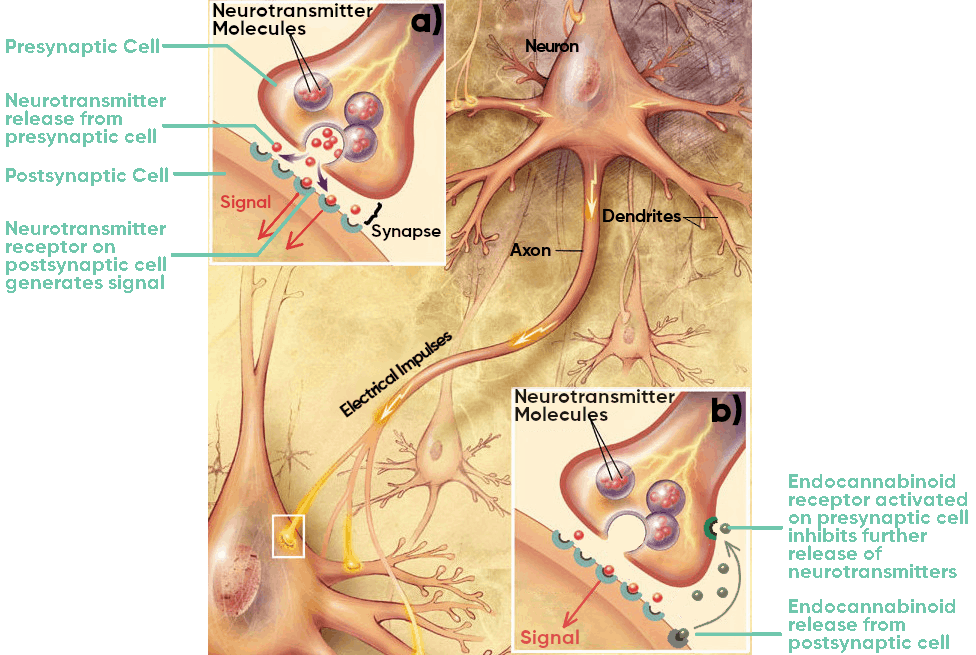Signaling
Once a
ligand binds to the
receptor, it causes a signal that triggers a response within the cell through so-called
intracellular pathways.
Normally, in communication between brain cells or other neurons (
intercellular signaling) a messenger is released from the pre-synapse {call-out, text:A synapse is a structure in the nervous system that permits a neuron (for example a brain cell) to pass the signal to another neuron. The pre-synaptic neuron is where the signal usually originates and the post-synaptic neuron usually receives the signal. For the cannabinoid system it works the other way around} and acts on a receptor on the post-synapse. With retrograde signaling, the messenger is released from the post-synapse and travels backwards, retrograde, to the pre-synapse. In the endocannabinoid system, the endocannabinoids anandamide (N-arachidonoyl-ethanolamine, AEA) and 2-arachidonoylglycerol (2-AG) are released from the post-synapse and bind to cannabinoid receptor on the pre-synapse (see Figure 1b).
 Figure 1: Retrograde signaling – The endocannabinoids anandamide and 2-arachidonoylglycerol are released from post-synaptic neurons. Once they are released, the endocannabinoids migrate to the pre-synaptic neuron, where they bind to the cannabinoid receptor-1 (CB1). When the CB1 receptor is activated, a cascade happens inside the neuron that results in a decrease in the release of neurotransmitters or messenger molecules, such as
Figure 1: Retrograde signaling – The endocannabinoids anandamide and 2-arachidonoylglycerol are released from post-synaptic neurons. Once they are released, the endocannabinoids migrate to the pre-synaptic neuron, where they bind to the cannabinoid receptor-1 (CB1). When the CB1 receptor is activated, a cascade happens inside the neuron that results in a decrease in the release of neurotransmitters or messenger molecules, such as GABA and glutamate
. By modulating neurotransmitter release, the endocannabinoid system can regulate homeostasis, or physiological balance in the body (image taken from Wikipedia; edited by Cannify).
 Figure 1: Retrograde signaling – The endocannabinoids anandamide and 2-arachidonoylglycerol are released from post-synaptic neurons. Once they are released, the endocannabinoids migrate to the pre-synaptic neuron, where they bind to the cannabinoid receptor-1 (CB1). When the CB1 receptor is activated, a cascade happens inside the neuron that results in a decrease in the release of neurotransmitters or messenger molecules, such as GABA and glutamate. By modulating neurotransmitter release, the endocannabinoid system can regulate homeostasis, or physiological balance in the body (image taken from Wikipedia; edited by Cannify).
Figure 1: Retrograde signaling – The endocannabinoids anandamide and 2-arachidonoylglycerol are released from post-synaptic neurons. Once they are released, the endocannabinoids migrate to the pre-synaptic neuron, where they bind to the cannabinoid receptor-1 (CB1). When the CB1 receptor is activated, a cascade happens inside the neuron that results in a decrease in the release of neurotransmitters or messenger molecules, such as GABA and glutamate. By modulating neurotransmitter release, the endocannabinoid system can regulate homeostasis, or physiological balance in the body (image taken from Wikipedia; edited by Cannify).
_logo.svg)